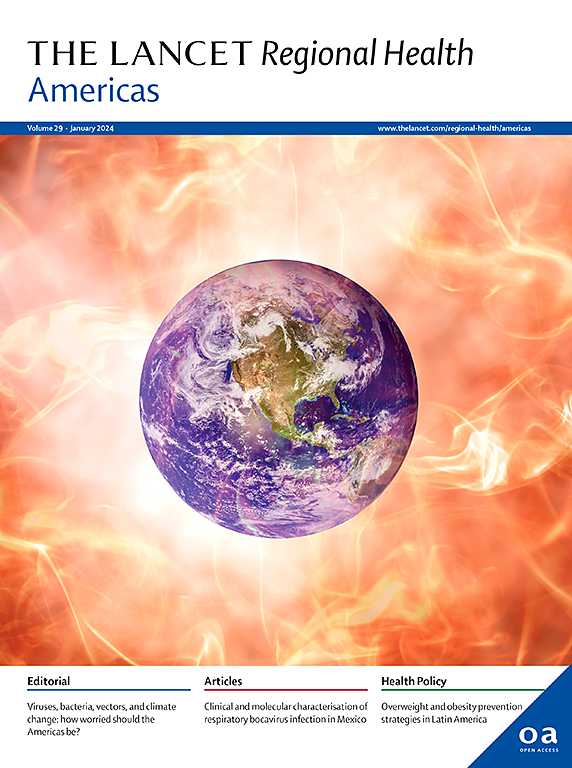巴西数字新生儿神经危重症护理:一项对11,000多名远程监测婴儿的回顾性多中心队列研究
IF 7
Q1 HEALTH CARE SCIENCES & SERVICES
引用次数: 0
摘要
新生儿脑损伤是一项重大的全球卫生挑战,对低收入和中等收入国家(LMIC)的影响尤为严重,在这些国家,获得专业护理的机会仍然有限。技术驱动的神经保护策略可能允许在资源受限的环境中传播专业护理。本研究描述了在巴西实施数字健康战略,为多个新生儿重症监护病房(nicu)提供专门的神经危重症护理。方法回顾性观察性多中心队列研究分析2017年7月至2024年6月巴西79个新生儿重症监护病房的数据。实施了一项数字卫生战略,包括实时视频振幅集成和原始脑电图(video- aeeg /EEG)、近红外光谱(NIRS)和生命体征监测,并由新生儿和儿科神经病学专家提供全天候服务。对床边服务人员的教育和培训是通过最初的面对面会议完成的,随后是在线培训。试点了一种沉浸式现实工具,用于在中央监测小组和床边小组之间进行磋商。研究结果:11333名新生儿接受了神经危重症护理,进行了727858小时的远程脑监测,监测中心和床边团队之间进行了124967次互动。新生儿以男性居多(57.7%),中位胎龄37周(IQR 32 ~ 39),平均出生体重2667 g (SD±635 g)。最常见的神经监测指征为疑似癫痫发作(23.3%)、中度或重度缺氧缺血性脑病(15.9%)和轻度缺氧缺血性脑病(13.3%)。在研究人群中,18.4%的人发现了电图癫痫发作,56.1%的人使用单一抗癫痫药物控制了癫痫发作。一线抗癫痫药物是苯巴比妥(97%)。24.9%的患者有病理aEEG/EEG背景型,41.2%的患者无睡眠-觉醒循环。同时采集1688例婴儿的视频- aeeg /EEG和NIRS监测数据。沉浸式现实于2023年在一个中心成功试点,加强了中央监测和床边团队之间的咨询,并标准化了执行修改后的Sarnat考试的医疗保健专业人员的培训。解释:将数字解决方案应用于跨远程和资源有限的中心的专门神经危重症护理和培训是可行的,并且有可能促进公平和提高对高危婴儿的护理质量。本文章由计算机程序翻译,如有差异,请以英文原文为准。
Digital neonatal neurocritical care in Brazil: a retrospective multicentre cohort study of over 11,000 remotely monitored infants
Background
Neonatal brain injury is a major global health challenge, disproportionately affecting low- and middle-income countries (LMIC), where access to specialized care remains limited. Technology-driven neuroprotective strategies may allow the dissemination of specialized care to resource-constrained settings. This study describes the implementation of a digital health strategy to deliver specialized neurocritical care to multiple neonatal intensive care units (NICUs) in Brazil.
Methods
Retrospective observational multicenter cohort study analyzing data from July 2017 to June 2024, from 79 NICUs across Brazil. A digital health strategy was implemented, incorporating real-time video amplitude-integrated and raw electroencephalography (video-aEEG/EEG), near-infrared spectroscopy (NIRS), and vital signs monitoring, supported by neonatology and pediatric neurology experts available 24/7. Education and training of bedside providers were accomplished by initial in-person sessions, followed by online training. An immersive reality tool was piloted to conduct consultations between the central monitoring and bedside teams.
Findings
11,333 neonates received neurocritical care with 727,858 h of remotely recorded brain monitoring and 124,967 interactions between monitoring centers and bedside teams. Most neonates were male (57.7%), the median gestational age was 37 weeks (IQR 32–39), and the mean birth weight was 2667 g (SD ± 635 g). The most common neuromonitoring indications were suspected seizures (23.3%), moderate or severe hypoxic-ischemic encephalopathy (15.9%), and mild hypoxic-ischemic encephalopathy (13.3%). In the study population, electrographic seizures were identified in 18.4%, and a single antiseizure medication achieved seizure control in 56.1%. The first line antiseizure medication was phenobarbital (97%). Pathologic aEEG/EEG background pattern was seen in 24.9%, and sleep-wake cycling was absent in 41.2%. Simultaneous video-aEEG/EEG and NIRS monitoring data were acquired from 1688 infants. Immersive reality was successfully piloted in 2023 in a single center, enhancing consultations between central monitoring and bedside teams and standardizing the training of healthcare professionals performing the modified Sarnat exam.
Interpretation
Applying digital solutions for specialized neurocritical care and training across distant and resource-limited centers is feasible and has the potential to promote equity and increase quality of care for high-risk infants.
Funding
None.
求助全文
通过发布文献求助,成功后即可免费获取论文全文。
去求助
来源期刊

Lancet Regional Health-Americas
Multiple-
CiteScore
8.00
自引率
0.00%
发文量
0
期刊介绍:
The Lancet Regional Health – Americas, an open-access journal, contributes to The Lancet's global initiative by focusing on health-care quality and access in the Americas. It aims to advance clinical practice and health policy in the region, promoting better health outcomes. The journal publishes high-quality original research advocating change or shedding light on clinical practice and health policy. It welcomes submissions on various regional health topics, including infectious diseases, non-communicable diseases, child and adolescent health, maternal and reproductive health, emergency care, health policy, and health equity.
 求助内容:
求助内容: 应助结果提醒方式:
应助结果提醒方式:


